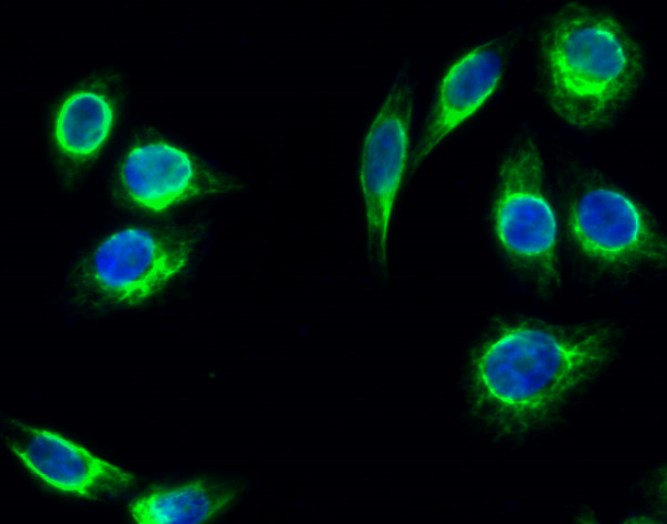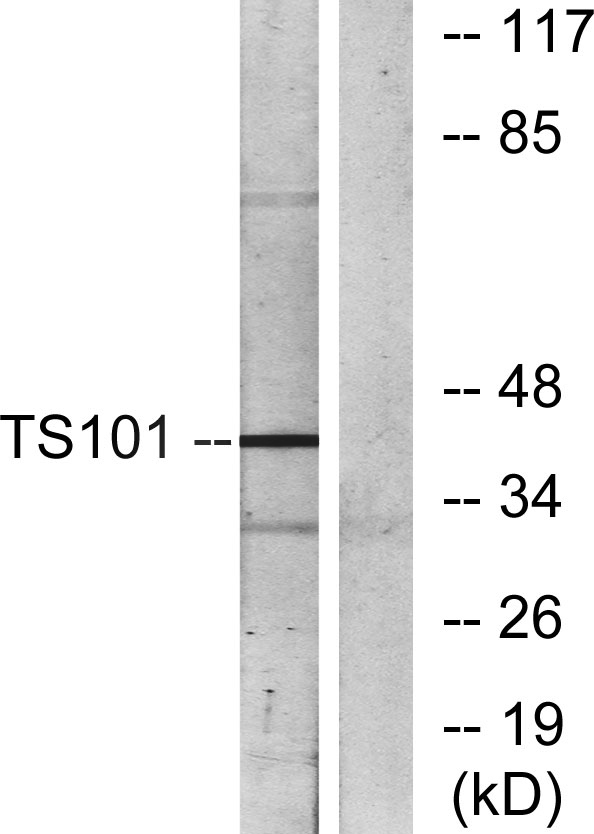Tsg 101 Polyclonal Antibody
- Catalog No.:YT4760
- Applications:WB;IHC;IF;ELISA
- Reactivity:Human;Mouse;Rat;Monkey
- Target:
- Tsg 101
- Fields:
- >>Viral life cycle - HIV-1;>>Endocytosis
- Gene Name:
- TSG101
- Protein Name:
- Tumor susceptibility gene 101 protein
- Human Gene Id:
- 7251
- Human Swiss Prot No:
- Q99816
- Mouse Gene Id:
- 22088
- Mouse Swiss Prot No:
- Q61187
- Rat Gene Id:
- 292925
- Rat Swiss Prot No:
- Q6IRE4
- Immunogen:
- The antiserum was produced against synthesized peptide derived from human TSG101. AA range:281-330
- Specificity:
- Tsg 101 Polyclonal Antibody detects endogenous levels of Tsg 101 protein.
- Formulation:
- Liquid in PBS containing 50% glycerol, 0.5% BSA and 0.02% sodium azide.
- Source:
- Polyclonal, Rabbit,IgG
- Dilution:
- WB 1:500 - 1:2000. IHC 1:100 - 1:300. IF 1:200 - 1:1000. ELISA: 1:5000. Not yet tested in other applications.
- Purification:
- The antibody was affinity-purified from rabbit antiserum by affinity-chromatography using epitope-specific immunogen.
- Concentration:
- 1 mg/ml
- Storage Stability:
- -15°C to -25°C/1 year(Do not lower than -25°C)
- Other Name:
- TSG101;Tumor susceptibility gene 101 protein;ESCRT-I complex subunit TSG101
- Observed Band(KD):
- 45kD
- Background:
- The protein encoded by this gene belongs to a group of apparently inactive homologs of ubiquitin-conjugating enzymes. The gene product contains a coiled-coil domain that interacts with stathmin, a cytosolic phosphoprotein implicated in tumorigenesis. The protein may play a role in cell growth and differentiation and act as a negative growth regulator. In vitro steady-state expression of this tumor susceptibility gene appears to be important for maintenance of genomic stability and cell cycle regulation. Mutations and alternative splicing in this gene occur in high frequency in breast cancer and suggest that defects occur during breast cancer tumorigenesis and/or progression. [provided by RefSeq, Jul 2008],
- Function:
- alternative products:Additional isoforms seem to exist. Several shorter isoforms are detected in primary breast cancers and other tumors,domain:The coiled coil domain may interact with stathmin.,domain:The UEV domain binds ubiquitin and P-[ST]-A-P peptide motif independently.,domain:The UEV domain is required for the interaction of the complex with ubiquitin. It also mediates the interaction with PTAP/PSAP motifs of HIV-1 P6 protein and human spumaretrovirus Gag protein.,function:Component of the ESCRT-I complex, a regulator of vesicular trafficking process. Binds to ubiquitinated cargo proteins and is required for the sorting of endocytic ubiquitinated cargos into multivesicular bodies (MVBs). Mediates the association between the ESCRT-0 and ESCRT-I complex. Required for completion of cytokinesis; the function requires CEP55. May be involved in cell growth and differentiation. Acts as a
- Subcellular Location:
- Cytoplasm . Early endosome membrane ; Peripheral membrane protein ; Cytoplasmic side . Late endosome membrane ; Peripheral membrane protein. Cytoplasm, cytoskeleton, microtubule organizing center, centrosome . Midbody, Midbody ring . Nucleus . Mainly cytoplasmic. Membrane-associated when active and soluble when inactive. Nuclear localization is cell cycle-dependent. Interaction with CEP55 is required for localization to the midbody during cytokinesis. .
- Expression:
- Heart, brain, placenta, lung, liver, skeletal, kidney and pancreas.
Salidroside Inhibits CCl4-Induced Liver Fibrosis in Mice by Reducing Activation and Migration of HSC Induced by Liver Sinusoidal Endothelial Cell-Derived Exosomal SphK1. Frontiers in Pharmacology Front Pharmacol. 2021 May;0:1195 WB Mouse,Human Liver,serum exosomes
Circulating Exosomal miRNAs as Novel Biomarkers for Stable Coronary Artery Disease. Biomed Research International 2020 Dec 11 WB Human 1:1000 Serum
Periodontal ligament fibroblasts regulate osteoblasts by exosome secretion induced by inflammatory stimuli. ARCHIVES OF ORAL BIOLOGY Arch Oral Biol. 2019 Sep;105:27 WB Human 1:300 hPDLFs
Phillygenin inhibited M1 macrophage polarization and reduced hepatic stellate cell activation by inhibiting macrophage exosomal miR-125b-5p BIOMEDICINE & PHARMACOTHERAPY Cheng Ma WB Mouse RAW264.7 cells
- June 19-2018
- WESTERN IMMUNOBLOTTING PROTOCOL
- June 19-2018
- IMMUNOHISTOCHEMISTRY-PARAFFIN PROTOCOL
- June 19-2018
- IMMUNOFLUORESCENCE PROTOCOL
- September 08-2020
- FLOW-CYTOMEYRT-PROTOCOL
- May 20-2022
- Cell-Based ELISA│解您多样本WB检测之困扰
- July 13-2018
- CELL-BASED-ELISA-PROTOCOL-FOR-ACETYL-PROTEIN
- July 13-2018
- CELL-BASED-ELISA-PROTOCOL-FOR-PHOSPHO-PROTEIN
- July 13-2018
- Antibody-FAQs
- Products Images

- Immunofluorescence analysis of Hela cell. 1,Tsg 101 Polyclonal Antibody(green) was diluted at 1:200(4° overnight). 2, Goat Anti Rabbit Alexa Fluor 488 Catalog:RS3211 was diluted at 1:1000(room temperature, 50min). 3 DAPI(blue) 10min.

- Western blot analysis of lysates from COS7 cells, using TS101 Antibody. The lane on the right is blocked with the synthesized peptide.

- Immunohistochemical analysis of paraffin-embedded human small intestinal carcinoma tissue. 1,primary Antibody was diluted at 1:200(4° overnight). 2, Sodium citrate pH 6.0 was used for antigen retrieval(>98°C,20min). 3,Secondary antibody was diluted at 1:200


